Surviving Mars missions will take planning and lots of innovation
Space is dangerous, especially when you can’t call home for help
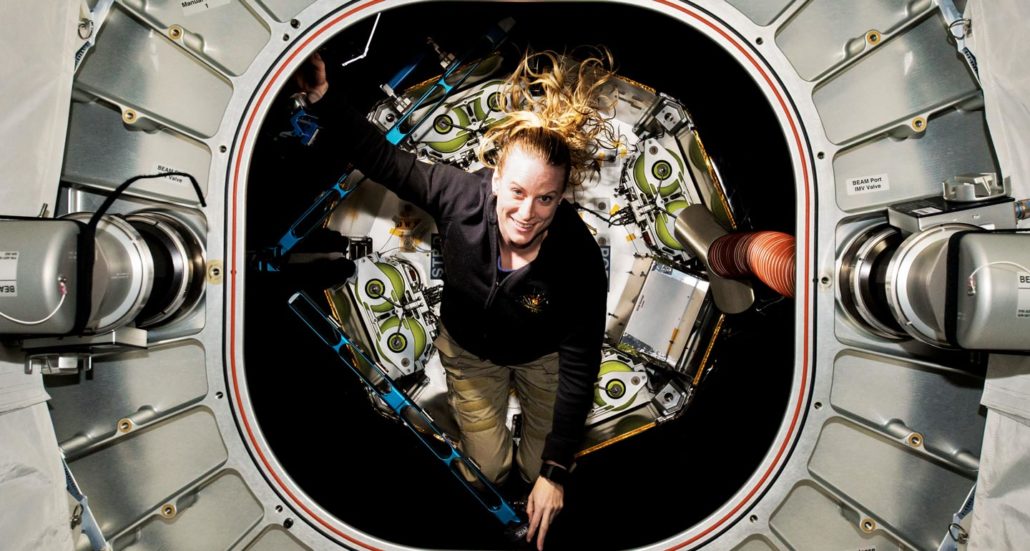
Scientists are studying how to protect astronauts on missions to Mars, where there will be minimal room for medical gear. Here, NASA astronaut Kate Rubins inspects a compact habitat on the International Space Station. It can be expanded into a living or work space.
NASA
On movie missions to Mars, getting there is the easy part. The Martian’s Mark Watney, for instance, was fine until a dust storm left him fending for himself. But in real life, dangers well beyond extreme weather face crews headed to the Red Planet.
“The mission to Mars is likely going to be four to six individuals [living] together in a can the size of a Winnebago for three years,” says Leticia Vega. She’s the associate chief scientist for the NASA Human Research Program in Houston, Texas. Time on the planet will be sandwiched between a six- to nine-month journey there plus the same long trip back.
Once in space, microgravity and radiation become big worries. Microgravity allows fluids to build up in the head. This can cause vision problems. And cruising through space will pelt adventurers with high-energy charged particles. These can zip right through the metal belly of a spacecraft. Researchers don’t know just how harmful this radiation is. However, lab tests suggest it could raise astronauts’ risk of cancer and other diseases.
It will also be a long trip. “The moon was like a camping trip when you think about going to Mars,” says Erik Antonsen. He’s an emergency medicine physician and aerospace engineer. He works at NASA’s Johnson Space Center in Houston.
Social and mental problem could develop among people trapped together inside a spacecraft. But beyond this, three years offers a lot more time and opportunity to get sick or injured than a days-long Apollo mission to the moon. And Mars is about 600 times farther from Earth than the moon is. Even light-speed communications will take about 20 minutes to reach Earth from Mars. So phoning Houston for help in an emergency is not an option.
“The reality is, when we do the first missions to Mars, there’s a high likelihood that somebody may die,” Antonsen says. “If someone goes out and they get an abrasion on their eyeball and it’s not responding to whatever [is] on the vehicle, they’re coming back one-eyed Jack.”
Despite those dangers, the United States, Russia, China and other nations have all voiced plans to send people to the Red Planet. NASA is gunning for a mission in the 2030s. So researchers are now at work on a suite of medical devices and medications to take on that trip.
This packing list is in its very early stages. In some cases, items on that list are still pretty impractical and unproven. Universal diagnostic wands are a distant dream. But researchers are devising artificial-gravity suits. They’re also at work on anti-radiation medications and mini medical tools. Scientists hope these will be ready in about a decade. That should be just in time to keep the first travelers to Mars safe and healthy.
Faking gravity
Floating in microgravity looks relaxing. But it is surprisingly bad for you. When the body doesn’t have to pull its own weight, muscles and bones weaken.
This was a big problem in the early days of spaceflight. In June 1970, the Soviet Soyuz 9 crew spent a record 18 days in space. When they landed, one cosmonaut was so weak that he couldn’t carry his own helmet as he stepped out of the landing capsule. Today, astronauts on the International Space Station have ways to keep up their strength. They exercise for a few hours each day. But other problems with life in microgravity remain unsolved.
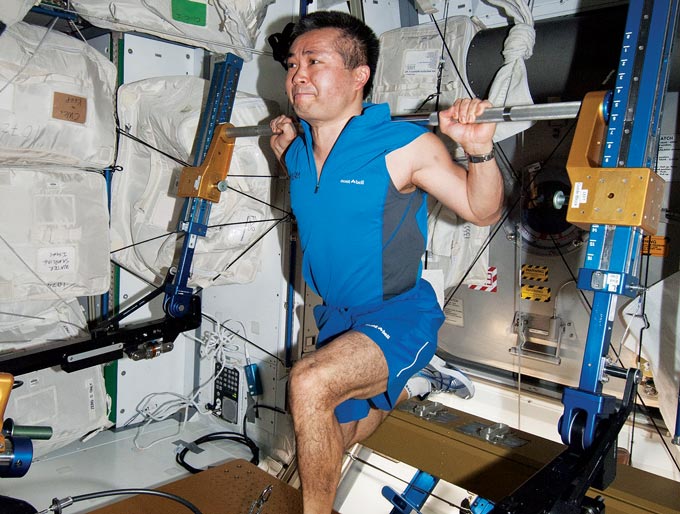
Earth’s gravity normally keeps fluid in the body from drifting toward the head. But in space, those fluids move upward. This increases pressure inside the skull. “If you were to sit down in a chair and put your head between your knees … that’s a bit what it feels like,” says Thomas Marshburn. He’s a NASA astronaut who spent five months aboard the space station in 2013.
About half of astronauts develop vision problems in space, such as farsightedness. “I had a harder time reading the keys on the laptop,” Marshburn recalls. Researchers suspect that constant elevated pressure behind the eyes is to blame.
Weightlessness also confuses the gravity-sensing organs in the inner ear. Those organs play a role in balance and motor control. Back on Earth, “I could walk in a straight line pretty easily by the end of that day,” Marshburn says. “But it took me a few days before I could start to walk around a corner” without running into the wall.
To help with these issues, a spaceship could be outfitted with artificial-gravity machines. One type is a lower-body negative-pressure, or LBNP, chamber. Someone is sealed inside it from the waist down. Then the device applies vacuum pressure to the lower half of the body. That pressure re-creates the downward pull of gravity. It plants the person’s feet firmly on the floor of the chamber. It also draws bodily fluids toward the legs.
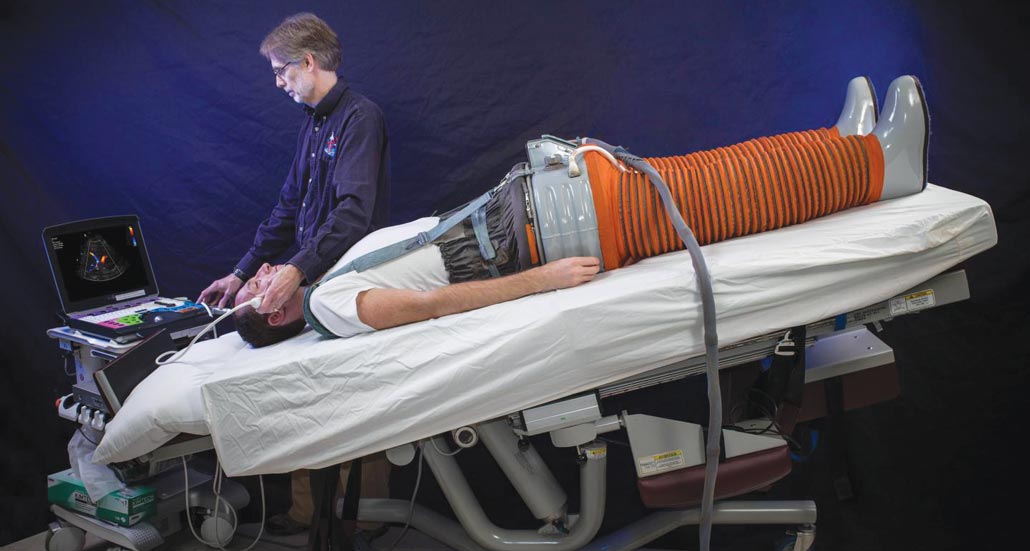
In one test of the concept, 10 volunteers sealed their lower bodies inside an LBNP chamber. They had to lie down to bring the intracranial pressure — that inside their skulls — closer to what it would be like in space. When someone on Earth goes from standing to lying down, that pressure rises from around 0 millimeters of mercury to about 15 mmHg. This is closer to what astronauts are thought to face in space. In the LBNP tests, researchers slowly increased the device’s vacuum pressure. And the recruits’ average intracranial pressure dropped from 15 to 9.4 mmHg. Researchers shared details of this, last year, in the Journal of Physiology.
“We really don’t know right now how much time [in LBNP] we need to protect the body” from harmful fluid shifts in space, says Alan Hargens. He’s a space physiologist who works at the University of California, San Diego. But in case LBNP becomes a major part of an astronaut’s day, Hargens’ team built a prototype LBNP suit for space. It can be worn during daily activity. The suit consists of a pair of overalls with built-in shoes. It seals around the waist. Vacuum pressure pulls the wearer down onto the shoe soles. Such LBNP devices “are an early form of artificial gravity,” Hargens says.
Another option is a centrifuge. This device uses centrifugal force to simulate gravity. It’s the same effect that keeps water in the bottom of a bucket when you swing it over your head. A centrifuge designed to help astronauts in microgravity looks a bit like a carousel with beds instead of ponies. The rider lies on a bed, head pointing toward the center of the carousel. Then the carousel spins. This exerts a horizontal centrifugal force out toward the feet. That force is as strong as the downward pull of gravity.
A room-sized centrifuge would be a lot harder to launch in a spaceship than an LBNP suit. But some researchers think the whole-body-centrifuge might combat microgravity issues that LBNP doesn’t. These include the inner-ear problems.
Rachael Seidler studies issues of the body’s motor control at the University of Florida in Gainesville. She was part of a team that looked into the effects of a centrifuge on motor control. To mimic life in microgravity, they kept 24 volunteers in bed for 60 days. Sixteen of the recruits spun in a centrifuge for a total of 30 minutes each day. The other eight didn’t get the daily ride. Before and after bedrest, participants were tested on their balance. They also were maneuvered an obstacle course. “We’ve just had a very preliminary peek” at the data, Seidler says, but “it does look like the artificial gravity was helpful” for motor control.
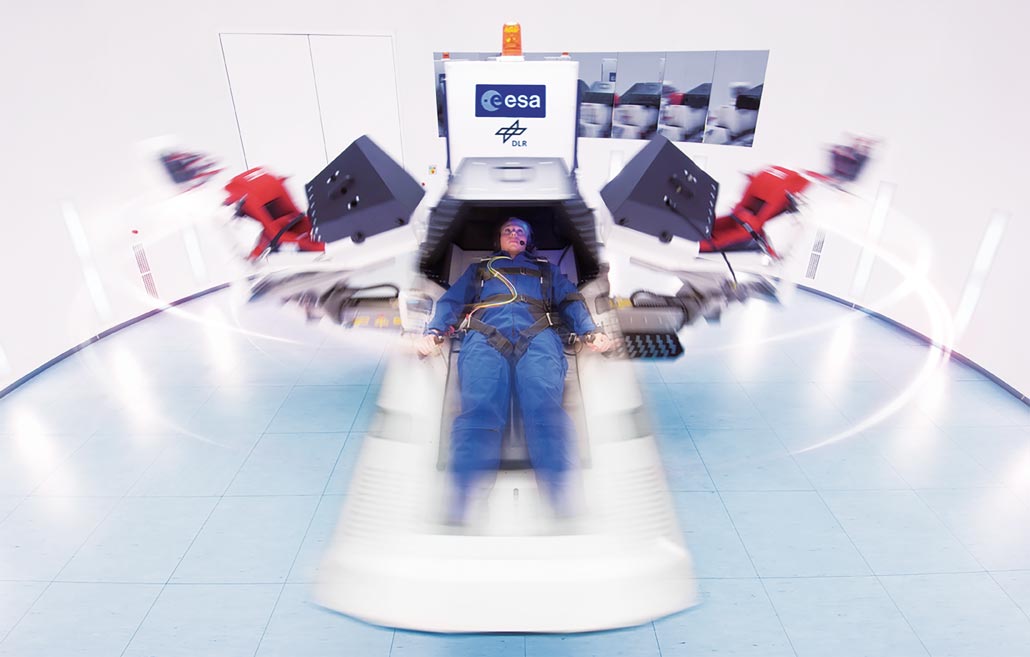
Bracing for radiation
At least microgravity is a familiar challenge to astronauts. Chronic exposure to deep-space radiation is different. No human has faced this before.
The solar system is awash in charged particles called galactic cosmic rays. Traveling at nearly the speed of light, they can tear through metal like it’s tissue paper. And they can kill cells or create mutations in DNA. Earth’s magnetic field largely protects astronauts on the space station from these tiny wrecking balls, just as it protects folks on Earth. But a Mars-bound crew will be totally exposed. En route to the Red Planet, astronauts are expected to receive almost two millisieverts of radiation daily. That’s roughly equal to getting a full-body CT scan every six days.
The only people ever fully immersed in deep-space radiation were those who went to the moon. But they were exposed for less than two weeks. On a Mars mission, “we really don’t know exactly what’s going to happen to humans when they get these types of exposures,” says Emmanuel Urquieta. He’s a space-medicine researcher at Baylor College of Medicine in Houston. But based on laboratory experiments, this radiation won’t be giving astronauts any superpowers.
In tests on animals and in human tissue, beams of particles designed to mimic space radiation degraded heart and blood-vessel tissues. That suggests a Mars crew may be at higher risk for cardiovascular disease. Similarly, studies of rodents exposed to radiation suggest space radiation harms mental functions.
“There’s also a good amount of data on radiation’s ability to induce cancer” in the lungs, liver and brain, says Peter Guida. He works at Brookhaven National Laboratory in Upton, N.Y. There he studies the biological effects of radiation.
Scary radiation effects seen in lab animals or cultured cells only gives hints to possible risks. A mouse is not a person. Brain cells in a dish do not make a brain. Also, animals and cells typically get the entire Mars mission–level dose of radiation in a single session or in a series of exposures over weeks or months. That is not the same thing as getting constant, low-level exposures. Still, data from these experiments are worrying. So researchers are testing various anti-radiation treatments.
One of the most promising of these is antioxidants, Guida says. Options include vitamins A and E. Another is selenomethionine. It’s an ingredient found in some dietary supplements. At various levels, all have been shown to lower the harmful effects of radiation, he says.
Medical problems astronauts are at relatively high risk of developing while in space:
- Rashes/skin irritations
- Motion sickness
- Insomnia
- Blood clots
- Back pain
- Nasal congestion
- Kidney stones
- Farsightedness
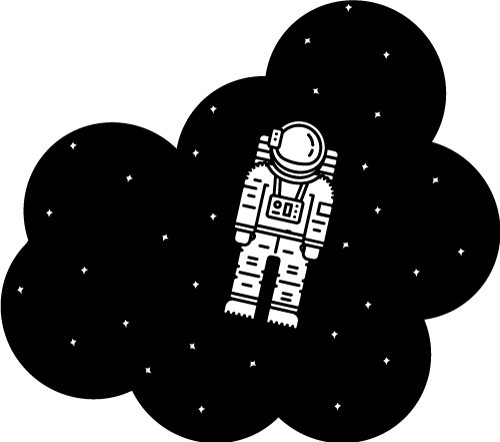
Even harnessing the natural antioxidant powers of berries might help. In one experiment, rats were fed food laced with freeze-dried blueberry powder for four weeks. They seemed to perform slightly better on a memory test after exposure to high-energy charged particles than rats that had been fed normal chow.
But antioxidants alone may not be good enough, says Marjan Boerma. She’s a radiation biologist at the University of Arkansas for Medical Sciences in Little Rock. Boerma is on a team that’s testing whether aspirin and other inflammation-fighters (including a form of vitamin E) can help reduce the harm to cells from high-energy particles. It may take a medley of drugs. Or it might be a carefully blended smoothie. Scientists are still far from deciding the exact recipe for that anti-radiation regimen, she says.
Astronaut, heal thyself
Mars visitors also will have to deal with unexpected illnesses and injuries. And mission control won’t be able to talk them through an emergency.
A Mars crew may include a doctor. “But that person could also get sick,” Urquieta says. And no one will be an expert in everything medical. Ideally, the Mars spaceship would be equipped with artificial intelligence. That AI could pore over an astronaut’s symptoms and then recommend medical tests, make diagnoses and assign treatments.
But today, a reliable “Dr. AI” is nowhere close to reality.
Right now, the most sophisticated symptom-checkers are tools like VisualDx. Health care workers use this diagnostic software in hospitals and clinics. The user answers questions about a patient. These can include symptoms and features like age, sex or ethnic background. The program then narrows down possible diagnoses. For skin conditions, VisualDx can also analyze photos of someone’s skin. It’s now being expanded to help users assess ultrasound scans.
Art Papier is a dermatologist and chief executive officer at VisualDx. He and his team designed a version of the system for use in deep space. It works on a laptop without internet. The software doesn’t have to account for every possible diagnosis. An astronaut is unlikely to be infected with a disease from the tropics, for example. Instead, it will focus on medical conditions that astronauts may likely develop. These include rashes and kidney stones.
Douglas Ebert is a spaceflight physiologist and space-medicine scientist with KBR, Inc. in Houston. He is part of a group developing a software tool called the Autonomous Medical Officer Support, or AMOS. It will help walk astronauts through first aid and medical exams. An early version of it uses pictures and videos. These can teach novices how to perform an eye exam, for instance, or insert a breathing tube.
The researchers tested an AMOS prototype with about 30 recruits who were not physicians. Those people learned how to perform several medical procedures. They then came back three to nine months later to do the procedures again. They could use the software, as needed, to guide them. This mimicked how an astronaut would use AMOS for preflight training and in-the-moment support during an emergency.
Measuring up
About 30 non-doctors learned first aid from a software system designed to help astronauts. Months after training, these people did pretty well, except for inserting a breathing tube and an IV.
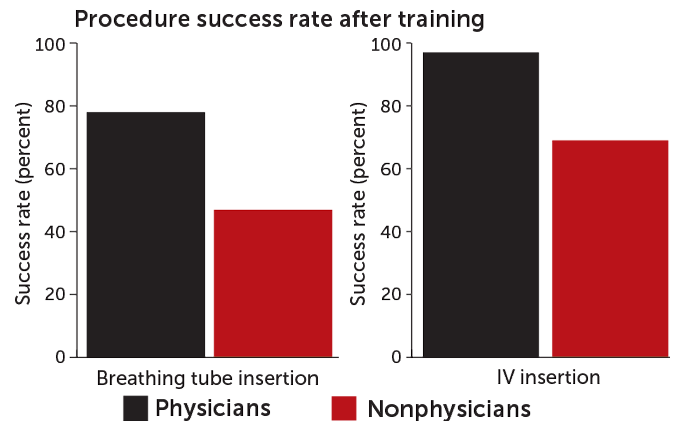
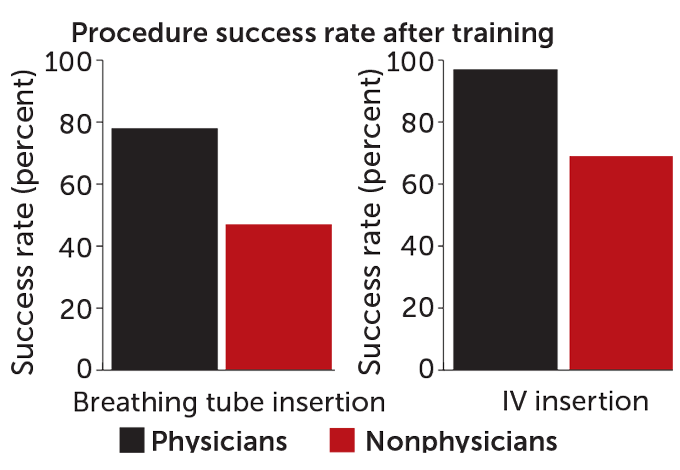
Source: D. Ebert et al/NASA Human Research Program Investigators’ Workshop 2020
Some 80 percent of these people accurately performed eye exams and ultrasounds. About 70 percent correctly inserted an IV. When it came to a tougher task — inserting a breathing tube — only about half pulled it off. Ebert and his colleagues reported this in January in Galveston, Texas. They presented it at a workshop on NASA’s Human Research Program.
Scanning and medical testing for space
In April, astronauts on board the space station successfully used the new software. It helped them scan kidneys and bladders using ultrasound. And they did this with no help from ground control.
When performing medical exams, astronauts won’t have the starship Enterprise’s sick bay at their disposal. They’ll need mini medical devices that fit on the spacecraft.
For medical imaging, space-medicine researchers have their eyes on a new ultrasound device. Called the Butterfly iQ, it can image different body parts. It replaces the variety of devices usually needed to do this with a single probe the size of an electric razor. That probe is lightweight and displays images on a mobile app.
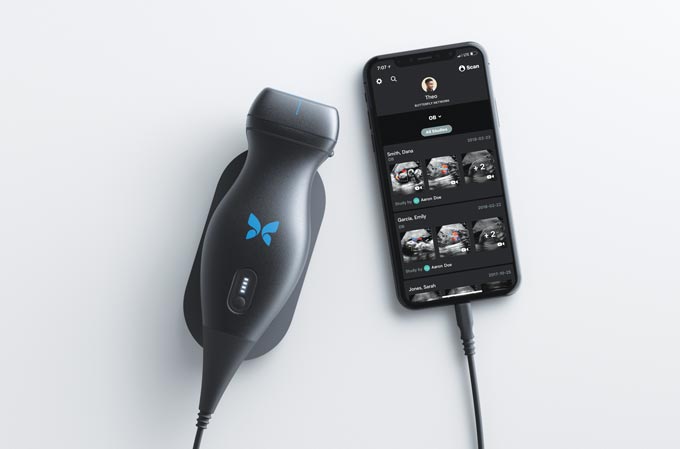
The company 1Drop Diagnostics is developing credit card–sized chips to detect chemical markers of disease. It analyzes blood samples from a finger prick. The company is also working on portable blood tests for astronauts.
The medical kit that astronauts use to patch each other up will have to be small and lightweight. To decide what goes in this first-aid kit, researchers use NASA’s Integrated Medical Model. This model forecasts which health problems the astronauts on a particular mission are most likely to have.
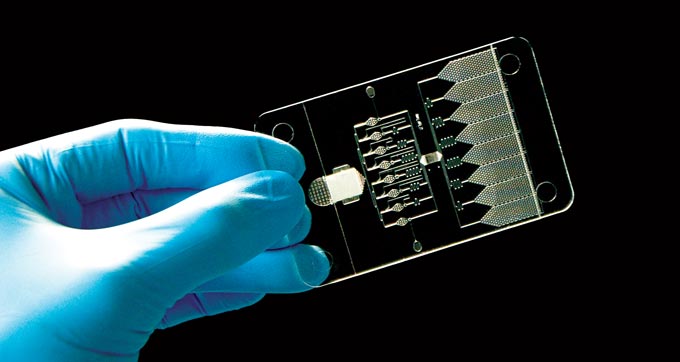
Researchers plug in mission details. This might include where the crew is headed. It also will consider astronauts’ genders and preexisting conditions. The model then runs thousands of mission simulations. It gauges the risks of that crew member having anything from constipation to a heart attack. Then planners can prioritize medical kit supplies.
Ebert of KBR in Houston and his team have already used this system to build a preliminary first-aid packing list. It’s for a lunar flyby mission that NASA has planned for 2022. For this three-week trip, the first-aid kit is pretty simple. It includes medication for such things as back pain and motion sickness.
Packing for Mars is going to be a whole new ball game, Ebert says. But researchers still have at least a decade to shrink their equipment down to size and figure out what mix of supplies will give Mars astronauts the best chance of surviving their epic voyage.







